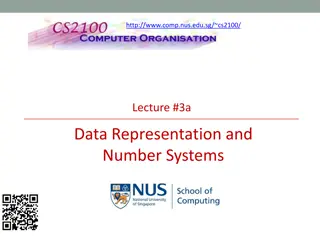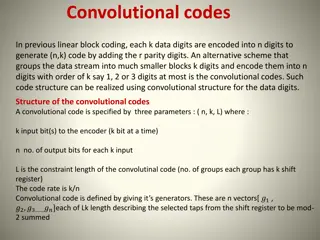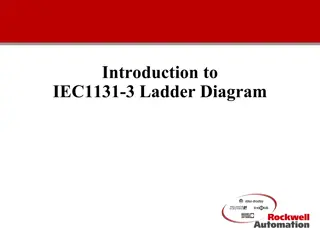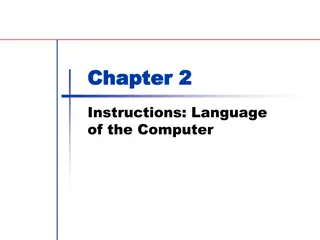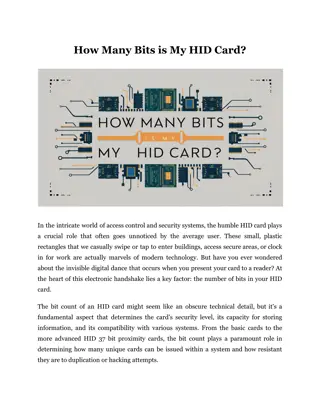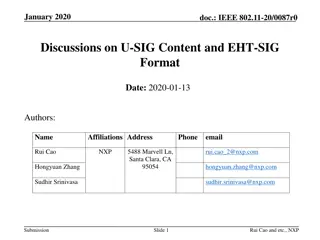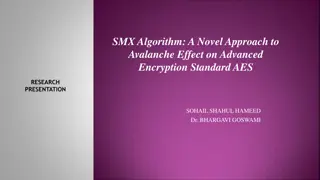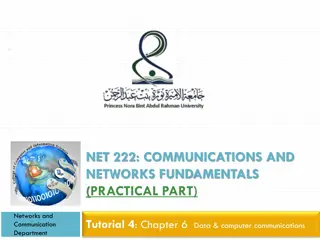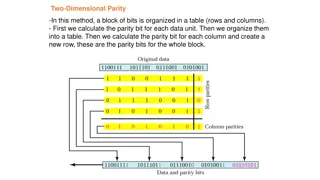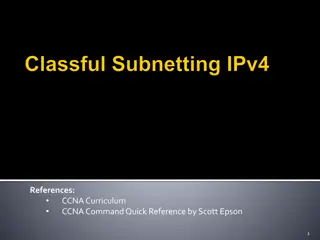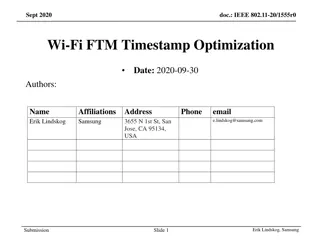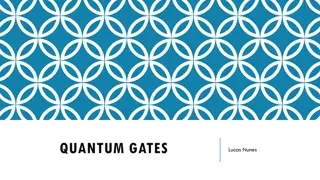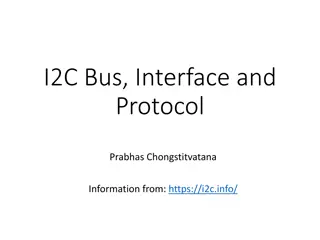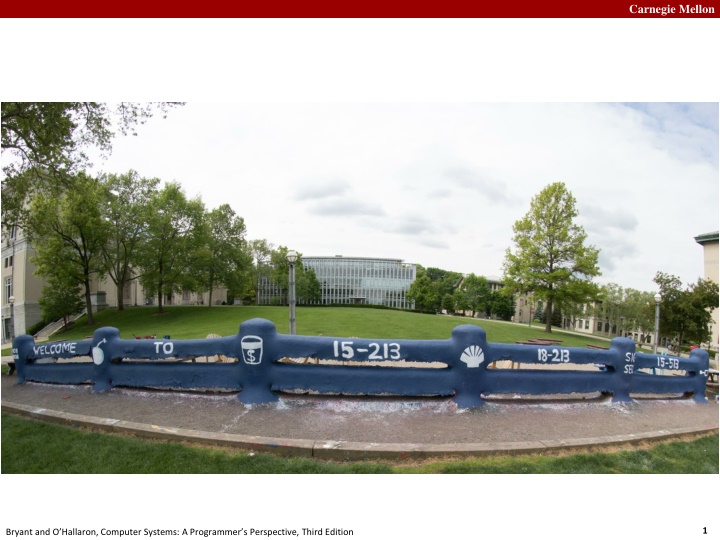
Computer Systems: Bits, Bytes, and Integers at Carnegie Mellon
"Explore the fundamentals of computer systems, including representations of information as bits, bit-level manipulations, integer representations, and more at Carnegie Mellon. Discover the essential role of bits in electronic implementation and information processing. Join the journey into the world of digital and analog computing with insights from Carnegie Mellon's Computer Systems course."
Download Presentation

Please find below an Image/Link to download the presentation.
The content on the website is provided AS IS for your information and personal use only. It may not be sold, licensed, or shared on other websites without obtaining consent from the author. If you encounter any issues during the download, it is possible that the publisher has removed the file from their server.
You are allowed to download the files provided on this website for personal or commercial use, subject to the condition that they are used lawfully. All files are the property of their respective owners.
The content on the website is provided AS IS for your information and personal use only. It may not be sold, licensed, or shared on other websites without obtaining consent from the author.
E N D
Presentation Transcript
Carnegie Mellon 1 Bryant and O Hallaron, Computer Systems: A Programmer s Perspective, Third Edition
Carnegie Mellon Bits, Bytes and Integers Part 1 15-213/18-213/14-513/15-513: Introduction to Computer Systems 2ndLecture, Aug. 29, 2019 2 Bryant and O Hallaron, Computer Systems: A Programmer s Perspective, Third Edition
Carnegie Mellon Announcements Recitations are on Mondays, but next Monday (9/2) is Labor Day, so recitations are cancelled Linux Boot Camp Monday evening 7pm, Rashid Auditorium Lab 0 is now available via course web page and Autolab. Due Thu Sept. 5, 11:00pm No grace days No late submissions Just do it! 3 Bryant and O Hallaron, Computer Systems: A Programmer s Perspective, Third Edition
Carnegie Mellon Today: Bits, Bytes, and Integers Representing information as bits Bit-level manipulations Integers Representation: unsigned and signed Conversion, casting Expanding, truncating Addition, negation, multiplication, shifting Summary Representations in memory, pointers, strings 5 Bryant and O Hallaron, Computer Systems: A Programmer s Perspective, Third Edition
Carnegie Mellon Everything is bits Each bit is 0 or 1 By encoding/interpreting sets of bits in various ways Computers determine what to do (instructions) and represent and manipulate numbers, sets, strings, etc Why bits? Electronic Implementation Easy to store with bistable elements Reliably transmitted on noisy and inaccurate wires 0 1 0 1.1V 0.9V 0.2V 0.0V 6 Bryant and O Hallaron, Computer Systems: A Programmer s Perspective, Third Edition
Carnegie Mellon Antikythera (ancient) analog computer 7 Bryant and O Hallaron, Computer Systems: A Programmer s Perspective, Third Edition
Carnegie Mellon (not ancient) Digital+Analog AI processor with all memory on chip in 28nm CMOS Bankman et al, An always-on 3.8 J/86% CIFAR-10 mixed-signal binary CNN processor with all memory on chip in 28nm CMOS 8 Bryant and O Hallaron, Computer Systems: A Programmer s Perspective, Third Edition
Carnegie Mellon Everything is bits Each bit is 0 or 1 By encoding/interpreting sets of bits in various ways Computers determine what to do (instructions) and represent and manipulate numbers, sets, strings, etc Why bits? Electronic Implementation Easy to store with bistable elements Reliably transmitted on noisy and inaccurate wires 0 1 0 1.1V 0.9V 0.2V 0.0V 9 Bryant and O Hallaron, Computer Systems: A Programmer s Perspective, Third Edition
Carnegie Mellon For example, can count in binary Base 2 Number Representation Represent 1521310 as 111011011011012 Represent 1.2010as 1.0011001100110011[0011] 2 Represent 1.5213 X 104 as 1.11011011011012 X 213 10 Bryant and O Hallaron, Computer Systems: A Programmer s Perspective, Third Edition
Carnegie Mellon Encoding Byte Values 0 1 2 3 4 5 6 7 8 9 A B C D E F 0 1 2 3 4 5 6 7 8 9 10 11 12 13 14 15 0000 0001 0010 0011 0100 0101 0110 0111 1000 1001 1010 1011 1100 1101 1110 1111 Byte = 8 bits Binary 000000002 to 111111112 Decimal: 010 to 25510 Hexadecimal 0016 to FF16 Base 16 number representation Use characters 0 to 9 and A to F Write FA1D37B16 in C as 0xFA1D37B 0xfa1d37b 15213: 0011 1011 0110 1101 3 B 6 D 11 Bryant and O Hallaron, Computer Systems: A Programmer s Perspective, Third Edition
Carnegie Mellon Example Data Representations C Data Type Typical 32-bit Typical 64-bit x86-64 char 1 1 1 short 2 2 2 int 4 4 4 long 4 8 8 float 4 4 4 double 8 8 8 pointer 4 8 8 12 Bryant and O Hallaron, Computer Systems: A Programmer s Perspective, Third Edition
Carnegie Mellon Example Data Representations C Data Type Typical 32-bit Typical 64-bit x86-64 char 1 1 1 short 2 2 2 int 4 4 4 long 4 8 8 float 4 4 4 double 8 8 8 pointer 4 8 8 13 Bryant and O Hallaron, Computer Systems: A Programmer s Perspective, Third Edition
Carnegie Mellon Today: Bits, Bytes, and Integers Representing information as bits Bit-level manipulations Integers Representation: unsigned and signed Conversion, casting Expanding, truncating Addition, negation, multiplication, shifting Summary Representations in memory, pointers, strings 14 Bryant and O Hallaron, Computer Systems: A Programmer s Perspective, Third Edition
Carnegie Mellon Boolean Algebra Developed by George Boole in 19th Century Algebraic representation of logic Encode True as 1 and False as 0 And Or A&B = 1 when both A=1 and B=1 A|B = 1 when either A=1 or B=1 Not Exclusive-Or (Xor) ~A = 1 when A=0 A^B = 1 when either A=1 or B=1, but not both 15 Bryant and O Hallaron, Computer Systems: A Programmer s Perspective, Third Edition
Carnegie Mellon General Boolean Algebras Operate on Bit Vectors Operations applied bitwise 01101001 & 01010101 01000001 01000001 01101001 | 01010101 01111101 01111101 01101001 ^ 01010101 00111100 00111100 ~ 01010101 10101010 10101010 All of the Properties of Boolean Algebra Apply 16 Bryant and O Hallaron, Computer Systems: A Programmer s Perspective, Third Edition
Carnegie Mellon Example: Representing & Manipulating Sets Representation Width w bit vector represents subsets of {0, , w 1} aj = 1 if j A 01101001 { 0, 3, 5, 6 } 76543210 01010101 { 0, 2, 4, 6 } 76543210 Operations & Intersection | Union ^ Symmetric difference ~ Complement 01000001 01111101 00111100 10101010 { 0, 6 } { 0, 2, 3, 4, 5, 6 } { 2, 3, 4, 5 } { 1, 3, 5, 7 } 17 Bryant and O Hallaron, Computer Systems: A Programmer s Perspective, Third Edition
Carnegie Mellon Bit-Level Operations in C Operations &, |, ~, ^ Available in C Apply to any integral data type 0 1 2 3 4 5 6 7 8 9 A B C D E F 0 1 2 3 4 5 6 7 8 9 10 11 12 13 14 15 0000 0001 0010 0011 0100 0101 0110 0111 1000 1001 1010 1011 1100 1101 1110 1111 long, int, short, char, unsigned View arguments as bit vectors Arguments applied bit-wise Examples (Char data type) ~0x41 0xBE ~010000012 101111102 ~0x00 0xFF ~000000002 111111112 0x69 & 0x55 0x41 011010012 & 010101012 010000012 0x69 | 0x55 0x7D 011010012 | 010101012 011111012 18 Bryant and O Hallaron, Computer Systems: A Programmer s Perspective, Third Edition
Carnegie Mellon Bit-Level Operations in C Operations &, |, ~, ^ Available in C Operations &, |, ~, ^ Available in C Apply to any integral data type Apply to any integral data type 0 1 2 3 4 5 6 7 8 9 A B C D E F 0 1 2 3 4 5 6 7 8 9 10 11 12 13 14 15 0000 0001 0010 0011 0100 0101 0110 0111 1000 1001 1010 1011 1100 1101 1110 1111 long, int, short, char, unsigned View arguments as bit vectors Arguments applied bit-wise Arguments applied bit-wise long, int, short, char, unsigned View arguments as bit vectors Examples (Char data type) Examples (Char data type) ~0x41 0xBE ~0x41 0xBE ~010000012 101111102 ~0x00 0xFF ~0x00 0xFF ~0100 00012 1011 11102 ~000000002 111111112 0x69 & 0x55 0x41 0x69 & 0x55 0x41 ~0000 00002 1111 11112 011010012 & 010101012 010000012 0x69 | 0x55 0x7D 0x69 | 0x55 0x7D 0110 10012 & 0101 01012 0100 00012 011010012 | 010101012 011111012 0110 10012 | 0101 01012 0111 11012 19 Bryant and O Hallaron, Computer Systems: A Programmer s Perspective, Third Edition
Carnegie Mellon Contrast: Logic Operations in C Contrast to Bit-Level Operators Logic Operations: &&, ||, ! View 0 as False Anything nonzero as True Always return 0 or 1 Early termination Examples (char data type) !0x41 0x00 !0x00 0x01 !!0x41 0x01 Watch out for && vs. & (and || vs. |) Super common C programming pitfall! 0x69 && 0x55 0x01 0x69 || 0x55 0x01 p && *p (avoids null pointer access) 20 Bryant and O Hallaron, Computer Systems: A Programmer s Perspective, Third Edition
Carnegie Mellon Shift Operations Left Shift: x << y Shift bit-vector x left y positions Throw away extra bits on left Argument x 01100010 << 3 00010000 00010000 00010000 Log. >> 2 00011000 00011000 00011000 Fill with 0 s on right Arith. >> 2 00011000 00011000 00011000 Right Shift: x >> y Shift bit-vector x right y positions Argument x 10100010 Throw away extra bits on right Logical shift << 3 00010000 00010000 00010000 Fill with 0 s on left Arithmetic shift Log. >> 2 00101000 00101000 00101000 Arith. >> 2 11101000 11101000 11 11101000 Replicate most significant bit on left Undefined Behavior Shift amount < 0 or word size 21 Bryant and O Hallaron, Computer Systems: A Programmer s Perspective, Third Edition
Carnegie Mellon Today: Bits, Bytes, and Integers Representing information as bits Bit-level manipulations Integers Representation: unsigned and signed Conversion, casting Expanding, truncating Addition, negation, multiplication, shifting Summary Representations in memory, pointers, strings Summary 22 Bryant and O Hallaron, Computer Systems: A Programmer s Perspective, Third Edition
Carnegie Mellon Encoding Integers Unsigned Two s Complement w 1 w 2 xw 1 2w 1+ xi 2i xi 2i = = B2U(X) B2T(X) i=0 i=0 short int x = 15213; short int y = -15213; Sign Bit C does not mandate using two s complement But, most machines do, and we will assume so C short 2 bytes long x y Decimal 15213 -15213 Hex 3B 6D 00111011 01101101 C4 93 11000100 10010011 Binary Sign Bit For 2 s complement, most significant bit indicates sign 0 for nonnegative 1 for negative 23 Bryant and O Hallaron, Computer Systems: A Programmer s Perspective, Third Edition
Carnegie Mellon Two-complement: Simple Example -16 0 8 1 4 0 2 1 1 0 10 = 8+2 = 10 -16 1 8 0 4 1 2 1 1 0 -10 = -16+4+2 = -10 24 Bryant and O Hallaron, Computer Systems: A Programmer s Perspective, Third Edition
Carnegie Mellon Two-complement Encoding Example (Cont.) x = 15213: 00111011 01101101 y = -15213: 11000100 10010011 Weight 15213 1 0 1 1 0 1 1 0 1 1 0 1 1 1 0 0 -15213 1 1 0 0 1 0 0 1 0 0 1 0 0 0 1 1 1 2 4 8 1 0 4 8 0 1 2 0 0 16 32 64 128 256 512 1024 2048 4096 8192 16384 -32768 Sum 16 0 0 128 32 64 0 256 512 0 0 0 1024 2048 4096 8192 0 0 0 0 0 16384 -32768 -15213 15213 25 Bryant and O Hallaron, Computer Systems: A Programmer s Perspective, Third Edition
Carnegie Mellon Numeric Ranges Unsigned Values UMin 000 0 UMax 111 1 Two s Complement Values TMin 100 0 TMax 011 1 Minus 1 111 1 = 0 2w 1 = = 2w 1 2w 1 1 = Values for W = 16 UMax TMax TMin -1 0 Decimal 65535 32767 -32768 Hex FF FF 11111111 11111111 7F FF 01111111 11111111 80 00 10000000 00000000 FF FF 11111111 11111111 00 00 00000000 00000000 Binary -1 0 26 Bryant and O Hallaron, Computer Systems: A Programmer s Perspective, Third Edition
Carnegie Mellon Values for Different Word Sizes W 8 255 127 -128 16 65,535 32,767 -32,768 32 64 UMax TMax TMin 4,294,967,295 2,147,483,647 -2,147,483,648 18,446,744,073,709,551,615 9,223,372,036,854,775,807 -9,223,372,036,854,775,808 Observations |TMin | = C Programming #include <limits.h> Declares constants, e.g., ULONG_MAX LONG_MAX LONG_MIN Values platform specific TMax + 1 Asymmetric range UMax = Question: abs(TMin)? 2 * TMax + 1 27 Bryant and O Hallaron, Computer Systems: A Programmer s Perspective, Third Edition
Carnegie Mellon Unsigned & Signed Numeric Values Equivalence Same encodings for nonnegative values X B2U(X) 0 1 2 3 4 5 6 7 B2T(X) 0 1 2 3 4 5 6 7 8 7 6 5 4 3 2 1 0000 0001 0010 0011 0100 0101 0110 0111 1000 1001 1010 1011 1100 1101 1110 1111 Uniqueness Every bit pattern represents unique integer value Each representable integer has unique bit encoding Can Invert Mappings U2B(x) = B2U-1(x) 8 9 10 11 12 13 14 15 Bit pattern for unsigned integer T2B(x) = B2T-1(x) Bit pattern for two s comp integer 28 Bryant and O Hallaron, Computer Systems: A Programmer s Perspective, Third Edition
Carnegie Mellon Quiz Time! Check out: https://canvas.cmu.edu/courses/10968 29 Bryant and O Hallaron, Computer Systems: A Programmer s Perspective, Third Edition
Carnegie Mellon Today: Bits, Bytes, and Integers Representing information as bits Bit-level manipulations Integers Representation: unsigned and signed Conversion, casting Expanding, truncating Addition, negation, multiplication, shifting Summary Representations in memory, pointers, strings 30 Bryant and O Hallaron, Computer Systems: A Programmer s Perspective, Third Edition
Carnegie Mellon Mapping Between Signed & Unsigned Unsigned Two s Complement T2U x ux T2B B2U X Maintain Same Bit Pattern Two s Complement x Unsigned U2T ux U2B B2T X Maintain Same Bit Pattern Mappings between unsigned and two s complement numbers: Keep bit representations and reinterpret 31 Bryant and O Hallaron, Computer Systems: A Programmer s Perspective, Third Edition
Carnegie Mellon Mapping Signed Unsigned Bits Signed Unsigned 0000 0001 0010 0011 0100 0101 0110 0111 1000 1001 1010 1011 1100 1101 1110 1111 0 1 2 3 4 5 6 7 0 1 2 3 4 5 6 7 8 9 T2U U2T -8 -7 -6 -5 -4 -3 -2 -1 10 11 12 13 14 15 32 Bryant and O Hallaron, Computer Systems: A Programmer s Perspective, Third Edition
Carnegie Mellon Mapping Signed Unsigned Bits Signed Unsigned 0000 0001 0010 0011 0100 0101 0110 0111 1000 1001 1010 1011 1100 1101 1110 1111 0 1 2 3 4 5 6 7 0 1 2 3 4 5 6 7 8 9 = -8 -7 -6 -5 -4 -3 -2 -1 10 11 12 13 14 15 +/- 16 33 Bryant and O Hallaron, Computer Systems: A Programmer s Perspective, Third Edition
Carnegie Mellon Relation between Signed & Unsigned Unsigned Two s Complement T2U x ux T2B B2U X Maintain Same Bit Pattern w 1 0 ux x + + + - + + + + + + + + Large negative weight becomes Large positive weight 34 Bryant and O Hallaron, Computer Systems: A Programmer s Perspective, Third Edition
Carnegie Mellon Conversion Visualized 2 s Comp. Ordering Inversion Negative Big Positive Unsigned UMax UMax 1 TMax + 1 Unsigned Range TMax TMax 2 s Complement 0 0 Range 1 2 TMin 35 Bryant and O Hallaron, Computer Systems: A Programmer s Perspective, Third Edition
Carnegie Mellon Signed vs. Unsigned in C Constants By default are considered to be signed integers Unsigned if have U as suffix 0U, 4294967259U Casting Explicit casting between signed & unsigned same as U2T and T2U int tx, ty; unsigned ux, uy; tx = (int) ux; uy = (unsigned) ty; Implicit casting also occurs via assignments and procedure calls tx = ux; int fun(unsigned u); uy = ty; uy = fun(tx); 36 Bryant and O Hallaron, Computer Systems: A Programmer s Perspective, Third Edition
Carnegie Mellon Casting Surprises Expression Evaluation If there is a mix of unsigned and signed in single expression, signed values implicitly cast to unsigned Including comparison operations <, >, ==, <=, >= Examples for W = 32: TMIN = -2,147,483,648 , TMAX = 2,147,483,647 Constant2 0 0U -1 0 -1 0U 2147483647 -2147483647-1 2147483647U -2147483647-1 -1 -2 (unsigned)-1 -2 2147483647 2147483648U Constant1 Relation Evaluation 0 0U 0 0U -2147483648 -2147483648 -2 -2 2147483648U (int) 2147483648U (int) 2147483648U == < > > < > > < > unsigned signed unsigned signed unsigned signed unsigned unsigned signed -1 -1 2147483647 2147483647U -1 (unsigned) -1 2147483647 2147483647 2147483647 37 Bryant and O Hallaron, Computer Systems: A Programmer s Perspective, Third Edition
Carnegie Mellon Summary Casting Signed Unsigned: Basic Rules Bit pattern is maintained But reinterpreted Can have unexpected effects: adding or subtracting 2w Expression containing signed and unsigned int int is cast to unsigned!! 39 Bryant and O Hallaron, Computer Systems: A Programmer s Perspective, Third Edition
Carnegie Mellon Today: Bits, Bytes, and Integers Representing information as bits Bit-level manipulations Integers Representation: unsigned and signed Conversion, casting Expanding, truncating Addition, negation, multiplication, shifting Summary Representations in memory, pointers, strings 40 Bryant and O Hallaron, Computer Systems: A Programmer s Perspective, Third Edition
Carnegie Mellon Sign Extension Task: Given w-bit signed integer x Convert it to w+k-bit integer with same value Rule: Make k copies of sign bit: X = xw 1 , , xw 1 , xw 1 , xw 2 , , x0 w k copies of MSB X X k w 41 Bryant and O Hallaron, Computer Systems: A Programmer s Perspective, Third Edition
Carnegie Mellon Sign Extension: Simple Example Positive number Negative number -16 8 4 2 1 -16 8 4 2 1 0 1 0 1 0 1 0 1 1 0 10 = -10 = -32 16 8 4 2 1 -32 16 8 4 2 1 0 0 1 0 1 0 1 1 0 1 1 0 10 = -10 = 42 Bryant and O Hallaron, Computer Systems: A Programmer s Perspective, Third Edition
Carnegie Mellon Larger Sign Extension Example short int x = 15213; int ix = (int) x; short int y = -15213; int iy = (int) y; Decimal 15213 15213 -15213 -15213 Hex Binary x ix y iy 3B 6D 00111011 01101101 00 00 3B 6D 00000000 00000000 00111011 01101101 C4 93 11000100 10010011 FF FF C4 93 11111111 11111111 11000100 10010011 Converting from smaller to larger integer data type C automatically performs sign extension 43 Bryant and O Hallaron, Computer Systems: A Programmer s Perspective, Third Edition
Carnegie Mellon Truncation Task: Given k+w-bit signed or unsigned integer X Convert it to w-bit integer X with same value for small enough X Rule: Drop top k bits: X = xw 1 , xw 2 , , x0 w k X w X 44 Bryant and O Hallaron, Computer Systems: A Programmer s Perspective, Third Edition
Carnegie Mellon Truncation: Simple Example No sign change Sign change -16 8 4 2 1 -16 8 4 2 1 0 0 0 1 0 0 1 0 1 0 2 = 10 = -8 4 2 1 -8 4 2 1 0 0 1 0 1 0 1 0 2 = -6 = 2 mod 16 = 2 10 mod 16 = 10U mod 16 = 10U = -6 -16 8 4 2 1 -16 8 4 2 1 1 1 0 1 0 1 0 1 1 0 -6 = -10 = -8 4 2 1 -8 4 2 1 1 0 1 0 0 1 1 0 -6 = 6 = -6 mod 16 = 26U mod 16 = 10U = -6 -10 mod 16 = 22U mod 16 = 6U = 6 45 Bryant and O Hallaron, Computer Systems: A Programmer s Perspective, Third Edition
Carnegie Mellon Summary: Expanding, Truncating: Basic Rules Expanding (e.g., short int to int) Unsigned: zeros added Signed: sign extension Both yield expected result Truncating (e.g., unsigned to unsigned short) Unsigned/signed: bits are truncated Result reinterpreted Unsigned: mod operation Signed: similar to mod For small (in magnitude) numbers yields expected behavior 46 Bryant and O Hallaron, Computer Systems: A Programmer s Perspective, Third Edition
Carnegie Mellon Summary of Today: Bits, Bytes, and Integers Representing information as bits Bit-level manipulations Integers Representation: unsigned and signed Conversion, casting Expanding, truncating Addition, negation, multiplication, shifting Representations in memory, pointers, strings Summary 47 Bryant and O Hallaron, Computer Systems: A Programmer s Perspective, Third Edition



